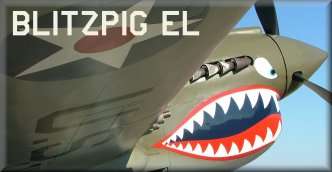
 |
|
#91
|
|||
|
|||
|
What's the other thing people usually ask for about the Mustang. There was a different engine boost setting for USAAF Mustang's used against Japan correct? Was that a higher setting or a lower one?
__________________
Find my missions and much more at Mission4Today.com |
|
#92
|
||||
|
||||
|
Quote:
Yeah, the stock (haven't tried anything else) is a bit twitchy. That is why I always flew with 100% sensitivity on all axes. With minimal rudder input and good trim she can shoot very steady, like I have shown in the video. But I do agree, it does have some issues. Not a show stopper, but not perfect either.
__________________
LEVEL BOMBING MANUAL v2.0 | Dedicated Bomber Squadron 'MUSTANG' - compilation of online air victories |
|
#93
|
||||
|
||||
|
Quote:
One of the mods does indeed reflect this with the later Mustangs (D25 D30) that they put in as new slot aircraft. I'd have to look at the MP next time I fly one to see, but it's well over 70". And a shameless plug for my favorite aircraft here... I'd still like to see the over boosted P40s that the USAAF and RAF used, both in the Pacific and North Africa. They were field modded to get 70 odd inches of mercury, which yielded something on the order of 1600 bhp at low levels.
__________________
 Personally speaking, the P-40 could contend on an equal footing with all the types of Messerschmitts, almost to the end of 1943. ~Nikolay Gerasimovitch Golodnikov |
|
#94
|
|||
|
|||
|
Quote:
__________________
Find my missions and much more at Mission4Today.com |
|
#95
|
|||
|
|||
|
Actually over-boosted models make a bigger difference in IL2 than they did in reality. That's why i was moaning about systems modelling and improved engine management for SoW
Those 70 inHG of manifold pressure or +11lbs of boost or 1.75 Ata and what not are settings we can run all day long in IL2. In reality power settings like those were used only for take-off and emergencies, usual limits being between 1 and 5 minutes and based on the amount of time it took a freshly started engine's temperature to climb to melting point where things start to break. Lining up on the tarmac on a hot day and being last for takeoff meant they were almost unattainable to begin with, flying high in cold air with mixture on the rich side and open radiators/cowl flaps could give a few extra seconds. True, it could make a difference if i'm trying to catch someone or i need that extra little bit of power to evade a bad situation, but by no means does it constitute any kind of permanent advantage in reality. Not only does overheat occur fast, cooling the engine equally fast will not solve the problem...in fact it can also cause damage due to expansion-contraction of the metal parts, but on the other hand i would still need to cool the engine as the longer it stays like that, the higher the risk of something breaking or an oil fire breaking out. Even if i bring it back within the limits, every second spent above them is damage and risk of malfunction that accumulates and doesn't just evaporate the moment i am back within the normal temperature envelope. Of course, we don't have those things in IL2 and that's why everyone prefers to fly the highest boosted variant of each type. Case in point the Spit +25lbs. In reality, maximum continuous boost for Spitfires was around between +8 and +10 lbs, anything higher than that came with a time limit and a rapidly climbing radiator coolant temperature. If the coolant temp exceeds 100 degrees Celsius or starts to evaporate, you're left with an engine that will either seize completely or is even more restricted by overheat in the amount of power it can produce. Sorry to be a killjoy, but unless we see some kind of engine paramameters modifications in a future patch i think we have enough high boost planes as it is |
|
#96
|
||||
|
||||
|
IceFire, check your PMs.
__________________
 Personally speaking, the P-40 could contend on an equal footing with all the types of Messerschmitts, almost to the end of 1943. ~Nikolay Gerasimovitch Golodnikov |
|
#97
|
|||
|
|||
|
I agree with Blackdog completely.
I would like to add that I feel it's too difficult to start an overheat in the first place. Another quirk is that the overheat doesn't do any damage to the engine until it's been in the overheat condition for at least a few minutes. |
|
#98
|
||||
|
||||
|
"Feeling" that something is too difficult is not good enough.
Empirical data is the only way to set such parameters. Frankly most aircraft in the sim overheat far too readily in flight, especially the air cooled birds, FW 190 A excepted.
__________________
 Personally speaking, the P-40 could contend on an equal footing with all the types of Messerschmitts, almost to the end of 1943. ~Nikolay Gerasimovitch Golodnikov |
|
#99
|
|||
|
|||
|
Quote:
|
|
#100
|
|||
|
|||
|
Quote:
In reality, things would be more gradual. The engine would start exhibiting troublesome behaviour earlier (this doesn't mean it would always be detectable though, it could a background occurence that would take extra abuse to show symptoms) which although not outright fatal, would accumulate over time for every instance the pilot pushed it beyond the normal envelope. |
 |
|
|